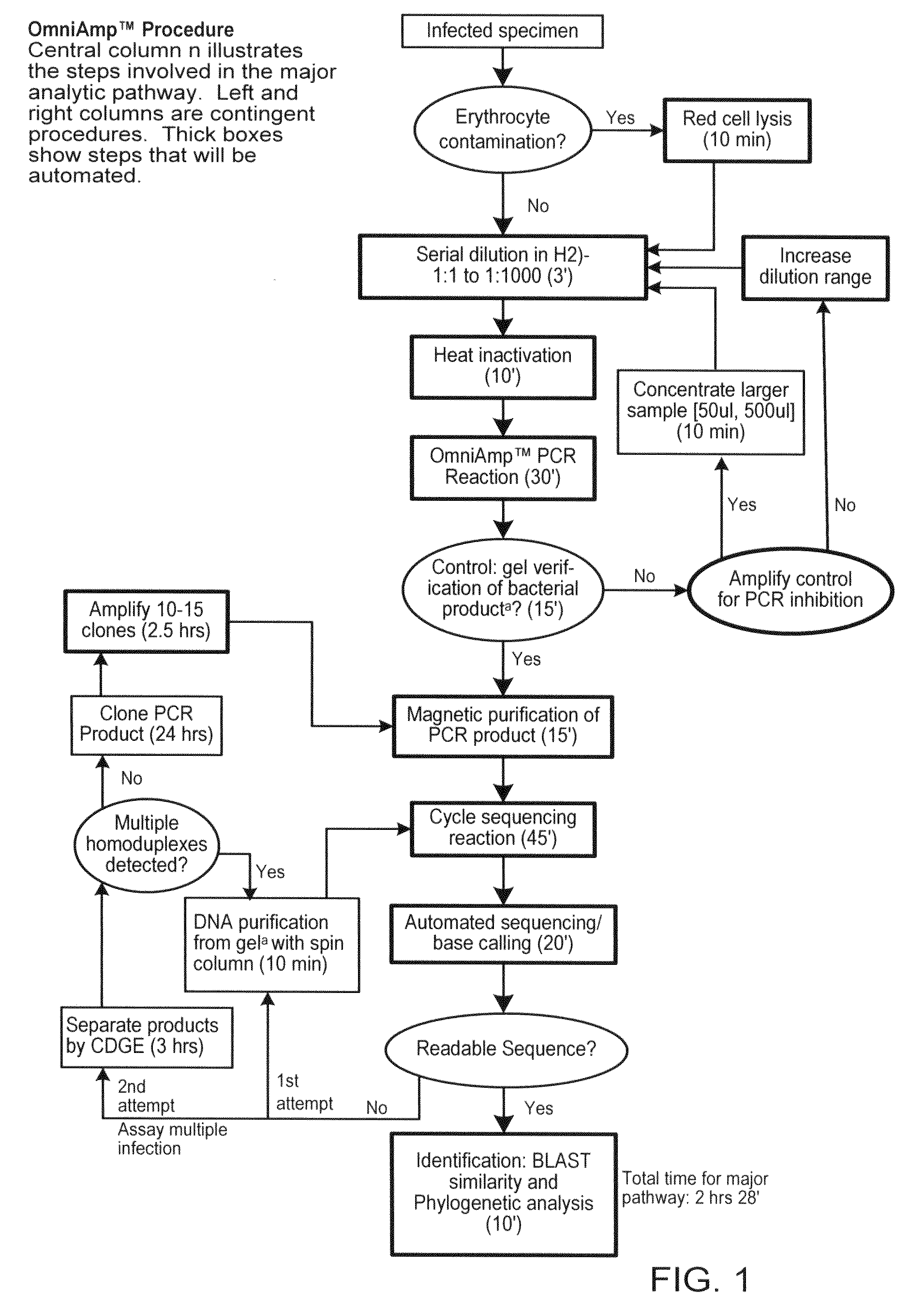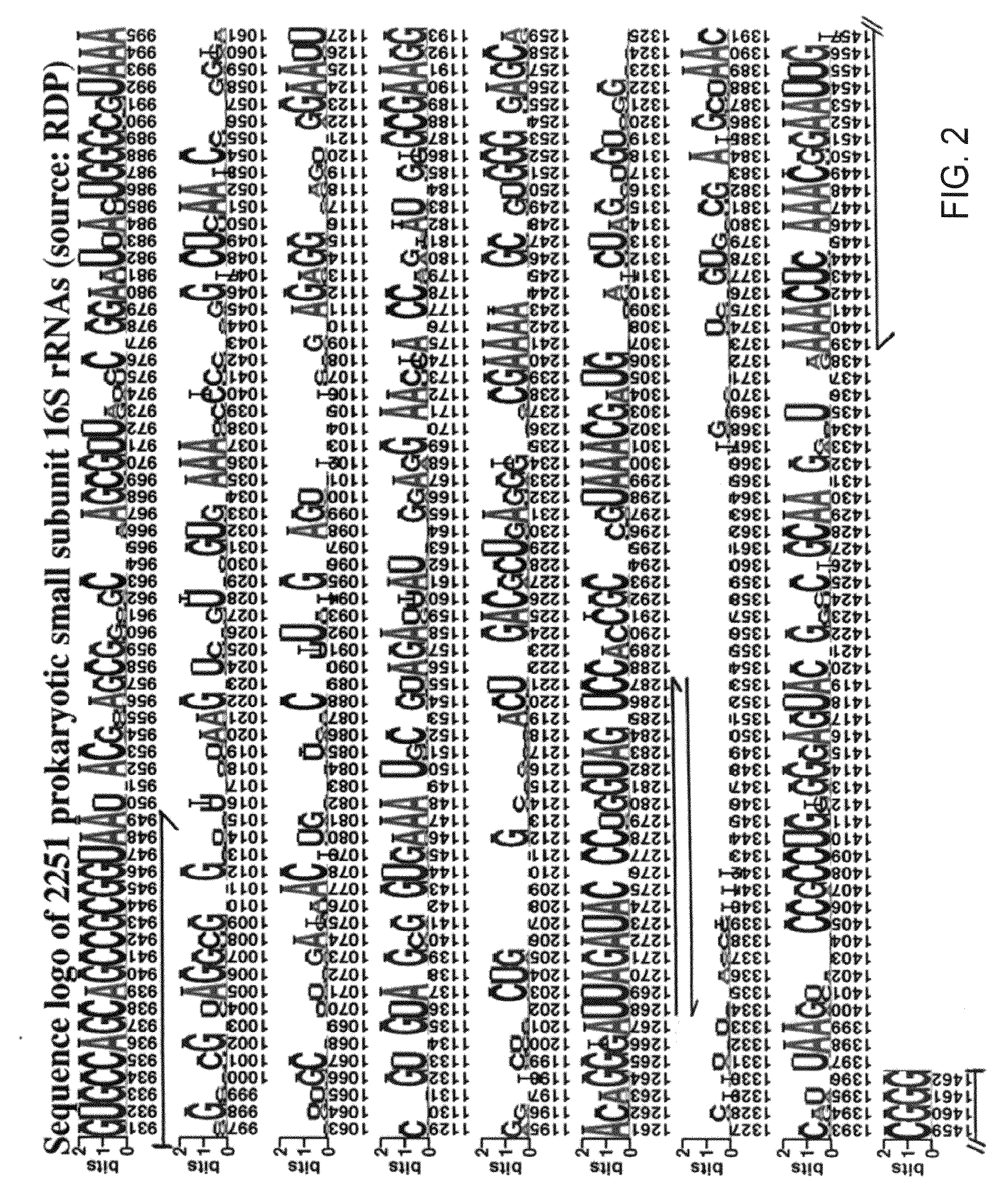Rapid and comprehensive identification of prokaryotic organisms
a prokaryotic organism and comprehensive technology, applied in the field of rapid detection and identification of microorganisms, can solve the problems of increasing the exposure of laboratory workers to pathogens, increasing the chances of pathogens being spread to others, and beer spoilage caused by bacteria is a chronic problem, so as to accurately identify a wide range of infectious disease agents
- Summary
- Abstract
- Description
- Claims
- Application Information
AI Technical Summary
Benefits of technology
Problems solved by technology
Method used
Image
Examples
example 1
Clinical Sample Preparation
Materials
[0056]TE buffer
[0057]disinfectant and squirt bottle
[0058]empty container for disinfectant
[0059]0.2 ml strip tubes
[0060]0.2, 0.5, 1.5 ml tubes
[0061]pipettes and sterile pipette tips (1000 ul, 200 ul, 20 ul)
[0062]Red blood cell lysis buffer (if using samples containing blood)
General Strategy
[0063]1) Perform standard sample preparation procedure.[0064]2) If this step doesn't result in an amplification product from the sample containing genomic sequences of the pathogen, it is necessary to concentrate the sample by centrifugation of 50 ul or, if available, 500 ul of the sample at high speed (>13000 g). This concentrates the sample containing the template and increases the chance of obtaining an amplification product.[0065]3) If the sample contains red blood cells (whether or not it is a sample of blood), perform sample preparation procedure for blood (#3).
Detailed Protocol
A. Standard Sample Preparation Dilution:
[0066]Put on a disposable lab coat, mask...
example 2
Preparation of Sequence Logo
[0139]A sequence logo was created from the aligned 16S rDNA sequences, and a representative region having two conserved regions surrounding a divergent region is shown in FIG. 2. The horizontal axis represents nucleotide positions along the DNA, whereas the vertical axis measures the degree of conservation at the same position in the various species. The vertical scale is given in bits of information (or Rsequence), which measures the number of choices between two equally likely possibilities. Rsequence may be calculated according to Equation I.
[0140]The choice of one base from the 4 possible bases requires two bits of information. The two bits correspond to two choices. For example, the first choice could determine whether the base is a purine or a pyrimidine and the second choice would specify which purine or pyrimidine is present. Thus, if at a certain position, all of the aligned 16S sequences have the same nucleotide, then that position has two bits ...
example 3
Design of Primers
[0142]In order to perform a PCR, two segments of DNA (which are referred to as primers) may be designed and prepared. The two PCR primers represent a set of oligomers in which set the frequency of a nucleotide is proportional to its presence at this particular position in the sequence logo prepared based on a number of 16S rDNA sequences from different organisms. The primers were designed according to the following three criteria: (1) They are in regions of high conservation, and surround regions of low conservation. (2) The 3′ termini cover regions that are invariant between species, so that the primer end which is extended by the DNA polymerase is always properly annealed to the DNA. (3) The oligonucleotide primers are not self complementary and do not base pair to each other. The primers may also contain restriction sites useful for subsequent cloning of the amplification product.
[0143]The following primers have been designed based on the Logo prepared in Example...
PUM
| Property | Measurement | Unit |
|---|---|---|
| thermal stability | aaaaa | aaaaa |
| mass spectrometry | aaaaa | aaaaa |
| electrophoresis | aaaaa | aaaaa |
Abstract
Description
Claims
Application Information
 Login to View More
Login to View More - R&D
- Intellectual Property
- Life Sciences
- Materials
- Tech Scout
- Unparalleled Data Quality
- Higher Quality Content
- 60% Fewer Hallucinations
Browse by: Latest US Patents, China's latest patents, Technical Efficacy Thesaurus, Application Domain, Technology Topic, Popular Technical Reports.
© 2025 PatSnap. All rights reserved.Legal|Privacy policy|Modern Slavery Act Transparency Statement|Sitemap|About US| Contact US: help@patsnap.com



